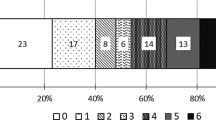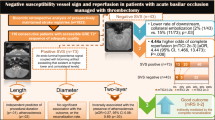Abstract
To report the occurrence of non-ischemic cerebral enhancing (NICE) lesions following mechanical thrombectomy (MT) through the retrospective French nationwide registry of NICE lesions. All thrombectomy capable stroke centers (TSC) in France were invited to fill out a questionnaire disseminated through a trainee-led research network (JENI-RC: Jeunes en Neuroradiologie Interventionnelle-Research Collaborative). NICE lesions were defined according to previous literature as delayed onset punctate, nodular, or annular foci enhancements with peri-lesion edema and vascular distribution in the territory of the MT with no other confounding disease. All 43 TSC French centers responded. Three patients were reported by 3 different centers over a total of 34,824 MT (2015–2020). Patient no. 1 developed symptomatic NICE lesions 8 weeks after MT with combination of aspiration and stentriever for a right middle cerebral artery occlusion. Patient no. 2 developed asymptomatic NICE lesions 5 weeks after MT with direct thromboaspiration for a right middle cerebral artery occlusion. Patient no. 3 developed symptomatic NICE lesions 6 weeks after MT with direct thromboaspiration, and combination of aspiration and stentriever for a basilar artery occlusion. This study provides evidence that NICE lesions following MT are a possible rare complication with a similar presentation as previously described following endovascular aneurysm treatment. Both radiologists and neurologists should be aware of this adverse event and make use of MRI contrast agents in case of unexplained symptoms/images during follow-up after MT.


Similar content being viewed by others
Abbreviations
- HPE:
-
Hydrophilic polymer emboli
- JENI-RC:
-
Jeunes en neuroradiologie interventionnelle
- NICE:
-
Non-ischemic cerebral enhancing
- SFNR:
-
French Society of Neuroradiology
- TSC:
-
Thrombectomy capable stroke centers
References
Shotar E, Law-Ye B, Baronnet-Chauvet F et al (2016) Non-ischemic cerebral enhancing lesions secondary to endovascular aneurysm therapy: nickel allergy or foreign body reaction? Case series and review of the literature. Neuroradiology 58:877–885. https://doi.org/10.1007/s00234-016-1699-5
Shotar E, Labeyrie M-A, Biondi A et al (2021) Non-ischemic cerebral enhancing lesions after intracranial aneurysm endovascular repair: a retrospective French national registry. J NeuroInterv Surg: neurintsurg-2021–017992. https://doi.org/10.1136/neurintsurg-2021-017992
Shapiro M, Ollenschleger MD, Baccin C et al (2015) Foreign body emboli following cerebrovascular interventions: clinical, radiographic, and histopathologic features. Am J Neuroradiol 36:2121–2126. https://doi.org/10.3174/ajnr.A4415
Mehta RI, Rai AT, Vos JA et al (2019) Intrathrombus polymer coating deposition: a pilot study of 91 patients undergoing endovascular therapy for acute large vessel stroke. Part I: Histologic frequency. J NeuroInterv Surg 11:1191–1196. https://doi.org/10.1136/neurintsurg-2018-014684
Abbasi M, Dai D, Liu Y et al (2021) Iatrogenic foreign materials associated with retrieved clot tissue via mechanical thrombectomy. Am J Neuroradiol. https://doi.org/10.3174/ajnr.A7106
Kerleroux B, Bourcier R, Rouchaud A et al (2021) Interventional neuroradiology trainee-led research collaborative JENI, moving forward. J Neuroradiol 48:137–138. https://doi.org/10.1016/j.neurad.2021.01.007
Chu Y-T, Lee K-P, Chen C-H et al (2020) Contrast-Induced encephalopathy after endovascular thrombectomy for acute ischemic stroke. Stroke 51:3756–3759. https://doi.org/10.1161/STROKEAHA.120.031518
Lorentzen AO, Nome T, Bakke SJ et al (2016) Cerebral foreign body reaction after carotid aneurysm stenting. Interv Neuroradiol 22:53–57. https://doi.org/10.1177/1591019915609171
Mehta RI, Mehta RI (2018) Hydrophilic polymer embolism: implications for manufacturing, regulation, and postmarket surveillance of coated intravascular medical devices. J Patient Saf. Publish Ahead of Print. https://doi.org/10.1097/PTS.0000000000000473
Stanley JRL, Tzafriri AR, Regan K et al (2016) Particulates from hydrophilic-coated guiding sheaths embolise to the brain. EuroIntervention 11:1435–1441. https://doi.org/10.4244/EIJY15M03_02
Fealey ME, Edwards WD, Giannini C et al (2008) Complications of endovascular polymers associated with vascular introducer sheaths and metallic coils in 3 patients, with literature review. Am J Surg Pathol 32:1310–1316. https://doi.org/10.1097/PAS.0b013e318165582a
Grewal SS, López Del Valle EM, Gupta V et al (2015) Neurological changes with abnormal brain reactivity following coiling of cerebral aneurysm. Possible reactivity to endovascular devices and material? J Vasc Interv Neurol 8:28–36
Acknowledgements
The authors thank the JENI members for this collaborative study.
Author information
Authors and Affiliations
Consortia
Contributions
Study design (GF, AR, FC, ES); data analysis (GF, ES); drafted the manuscript (GF); data acquisition (SE, JS, GF, SS, AM, LS, KH); revised and gave final approval for the manuscript (all authors).
Corresponding author
Ethics declarations
Conflict of interest
AR reports conflict of interest (unrelated) with Bal Extrusion. FC reports conflict of interest (unrelated) with Medtronic, Guerbet, Balt Extrusion (payment for readings), Codman Neurovascular (core lab).
The other authors report no disclosures relevant to the manuscript.
Ethical approval
The CERIM (Comité d’Ethique pour la Recherche en Imagerie Médicale) institutional review board approved this study (CRM-1912–045). The need for patient informed consent was waived for retrospective analyses of patients’ records. Data shall be made available upon reasonable request to the corresponding author.
Informed consent
Not required. According to national legislation, the need for signed patient informed consent was waived for retrospective analyses of patients’ records and imaging data.
Additional information
Publisher's note
Springer Nature remains neutral with regard to jurisdictional claims in published maps and institutional affiliations.
Supplementary Information
Below is the link to the electronic supplementary material.
Rights and permissions
About this article
Cite this article
Forestier, G., Escalard, S., Sedat, J. et al. Non-ischemic cerebral enhancing lesions after thrombectomy: a multicentric retrospective French national registry. Neuroradiology 64, 1037–1042 (2022). https://doi.org/10.1007/s00234-022-02919-8
Received:
Accepted:
Published:
Issue Date:
DOI: https://doi.org/10.1007/s00234-022-02919-8




